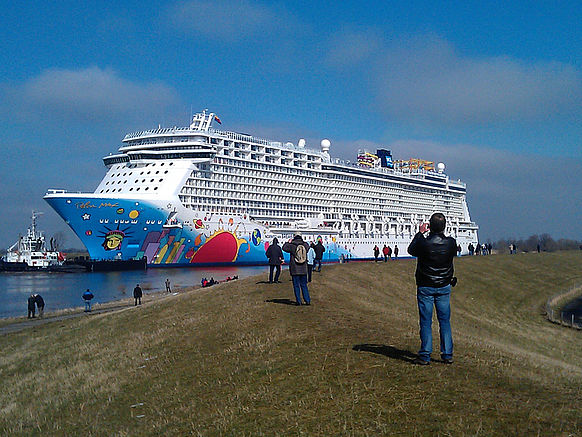Along with agriculture and tourism, ship transportation shapes the Ems region. While the shipping industry, as a sub-sector of the maritime economy, is largely concentrated in Haren and Leer, shipbuilding and port logistics are based in Papenburg and Emden. Bulk goods like salts, fertiliser, construction materials, and agricultural products are largely processed at the inland harbours of the Ems. Large industrial locations for the automotive industry, paper manufacturing, and wind energy plants, among others, have developed near these harbours, serving the Ems region and the global market.
Along the Ems federal waterway, nearly 15,000 employees work in this economic sector in the drainage basin of the Ems thoroughfare. According to an assessment released by the Lower Saxony Institute for Economic Research in 2014, Meyer Werft currently employs around 3100, half of whom come from the Emsland and Leer districts, plus more than 2200 full-time positions with direct vendors and more than 200 with indirect vendors. An employment effect of about 20,000 full-time positions in Germany is expected by 2017. One-fifth of vendors from the region benefit from technological advances and innovations, according to the report. With its strong development and engineering divisions, Meyer Werft is a crucial driving force for the development of this economic region with relatively few epicentres of innovation.
In addition to this are another estimated 20,000 positions with companies from sectors that directly depend on the harbours (e.g. VW, ENERCON, Nordland-Papier), vendors and companies working for corporations that depend on the harbours, and the expanded commerce and service sectors.
This immense employment volume with a strong regional base ensures a special degree of regional added value through its dynamic nature and innovation. Families, retail, and service providers thus benefit as much as the municipalities and districts of the Ems region who receive considerable fiscal revenue from the regional economic effects - and with it the creation and maintenance of local infrastructure and quality of living.
A sufficiently navigable, year-round federal waterway – the Ems – is crucial for shipbuilding, port logistics, and all other harbour-related sectors. However, the heavy sedimentary contamination of the Ems necessitates extensive dredging to keep the fairways at the necessary draught. The harbours along the Ems are also suffering from the massive silt contamination. The silt reduction measures suggested by the Master Plan Ems 2050 could thus lead to visible economic relief.






